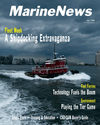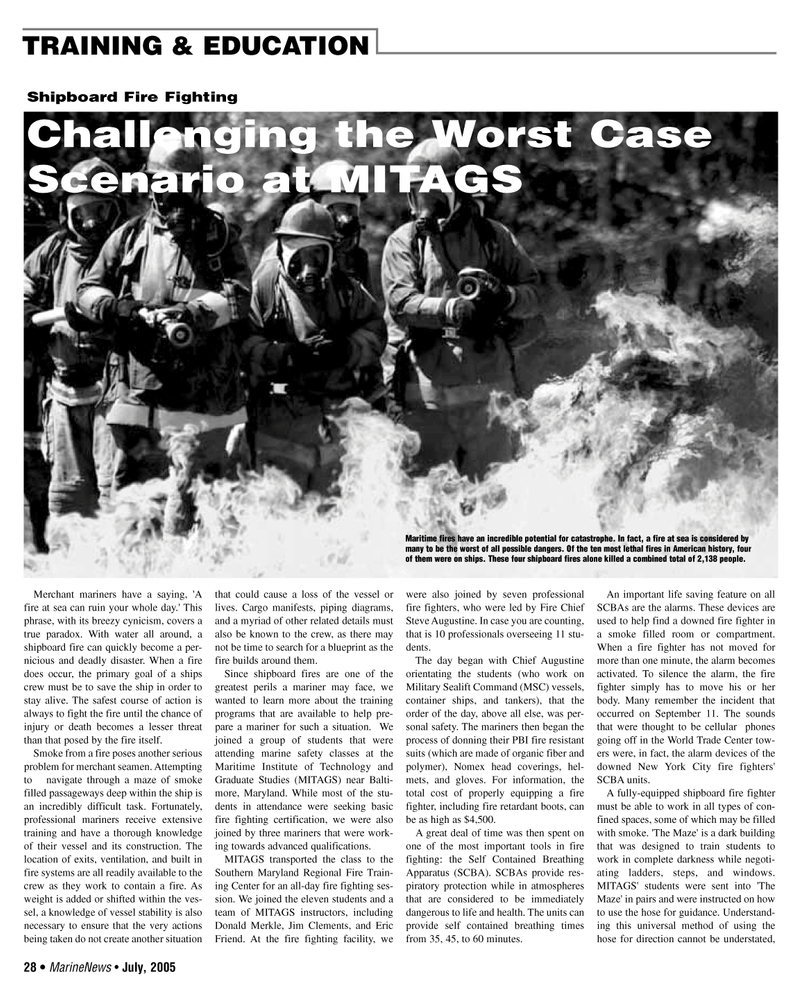
Page 28: of Marine News Magazine (July 2005)
Read this page in Pdf, Flash or Html5 edition of July 2005 Marine News Magazine
Merchant mariners have a saying, 'A fire at sea can ruin your whole day.' This phrase, with its breezy cynicism, covers a true paradox. With water all around, a shipboard fire can quickly become a per- nicious and deadly disaster. When a fire does occur, the primary goal of a ships crew must be to save the ship in order to stay alive. The safest course of action is always to fight the fire until the chance of injury or death becomes a lesser threat than that posed by the fire itself.
Smoke from a fire poses another serious problem for merchant seamen. Attempting to navigate through a maze of smoke filled passageways deep within the ship is an incredibly difficult task. Fortunately, professional mariners receive extensive training and have a thorough knowledge of their vessel and its construction. The location of exits, ventilation, and built in fire systems are all readily available to the crew as they work to contain a fire. As weight is added or shifted within the ves- sel, a knowledge of vessel stability is also necessary to ensure that the very actions being taken do not create another situation that could cause a loss of the vessel or lives. Cargo manifests, piping diagrams, and a myriad of other related details must also be known to the crew, as there may not be time to search for a blueprint as the fire builds around them.
Since shipboard fires are one of the greatest perils a mariner may face, we wanted to learn more about the training programs that are available to help pre- pare a mariner for such a situation. We joined a group of students that were attending marine safety classes at the
Maritime Institute of Technology and
Graduate Studies (MITAGS) near Balti- more, Maryland. While most of the stu- dents in attendance were seeking basic fire fighting certification, we were also joined by three mariners that were work- ing towards advanced qualifications.
MITAGS transported the class to the
Southern Maryland Regional Fire Train- ing Center for an all-day fire fighting ses- sion. We joined the eleven students and a team of MITAGS instructors, including
Donald Merkle, Jim Clements, and Eric
Friend. At the fire fighting facility, we were also joined by seven professional fire fighters, who were led by Fire Chief
Steve Augustine. In case you are counting, that is 10 professionals overseeing 11 stu- dents.
The day began with Chief Augustine orientating the students (who work on
Military Sealift Command (MSC) vessels, container ships, and tankers), that the order of the day, above all else, was per- sonal safety. The mariners then began the process of donning their PBI fire resistant suits (which are made of organic fiber and polymer), Nomex head coverings, hel- mets, and gloves. For information, the total cost of properly equipping a fire fighter, including fire retardant boots, can be as high as $4,500.
A great deal of time was then spent on one of the most important tools in fire fighting: the Self Contained Breathing
Apparatus (SCBA). SCBAs provide res- piratory protection while in atmospheres that are considered to be immediately dangerous to life and health. The units can provide self contained breathing times from 35, 45, to 60 minutes.
An important life saving feature on all
SCBAs are the alarms. These devices are used to help find a downed fire fighter in a smoke filled room or compartment.
When a fire fighter has not moved for more than one minute, the alarm becomes activated. To silence the alarm, the fire fighter simply has to move his or her body. Many remember the incident that occurred on September 11. The sounds that were thought to be cellular phones going off in the World Trade Center tow- ers were, in fact, the alarm devices of the downed New York City fire fighters'
SCBA units.
A fully-equipped shipboard fire fighter must be able to work in all types of con- fined spaces, some of which may be filled with smoke. 'The Maze' is a dark building that was designed to train students to work in complete darkness while negoti- ating ladders, steps, and windows.
MITAGS' students were sent into 'The
Maze' in pairs and were instructed on how to use the hose for guidance. Understand- ing this universal method of using the hose for direction cannot be understated, 28 • MarineNews • July, 2005
TRAINING & EDUCATION
Shipboard Fire Fighting
Challenging the Worst Case
Scenario at MITAGS
Maritime fires have an incredible potential for catastrophe. In fact, a fire at sea is considered by many to be the worst of all possible dangers. Of the ten most lethal fires in American history, four of them were on ships. These four shipboard fires alone killed a combined total of 2,138 people.
JULYMN2005 4(25-32).qxd 6/30/2005 3:31 PM Page 28

 27
27

 29
29
